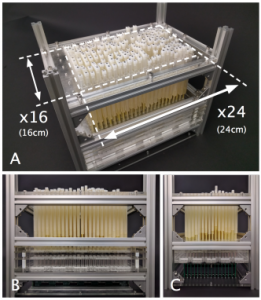
The researchers describe their vision of 3D printing as an interactive medium. The idea is that the 3D printer takes only seconds to assemble an object, which can then be just as quickly disassembled and the components used to form something new.
“For example, such a 3D printer could be used in a Virtual Reality or Augmented Reality application to dynamically form a tangible object or controller to provide haptic feedback and engage users physically,” the researchers suggest.
Other applications could include educational models for children, such as molecular or architectural models, or means for designers to show a product to clients and interactively change the product’s design while the clients watch.
“In this vision, Dynamic 3D printing is an environment in which the user thinks, designs, explores, and communicates through dynamic and interactive physical representation,” the researchers state.
Their design for dynamic 3D printing involves two key components: a parallel assembler and a rapid connection and disconnection mechanism. Taking inspiration from DLP 3D printing, their assembly method forms entire layers in parallel rather than assembling each individual element in sequence. A fast connection and disconnection method allows layers to be quickly stacked into a stable shape.
Dynablock’s shapes are made with 9mm blocks, which connect to neighboring blocks with embedded magnets. The hardware uses a 24 x 16 pin-based shape display as a parallel assembler. 3,072 blocks are stacked atop the shape display, and motorized pins push up blocks to assemble the object layer by layer. As the blocks are pushed up and out of the assembler, they connect with their neighbors via the magnets, forming an object. Because of weaker vertical magnetic connections, the blocks can disconnect vertically to form overhangs. The process takes only seconds, and the objects can be disassembled to form new ones.
Four properties are given for dynamic 3D printing: it is immediate, reconstructable, forms arbitrary shapes, and forms graspable objects. Four challenges are also mentioned: resolution, speed, scalability and stability. The researchers go on to describe in detail how they built the parallel assembler and connection and disconnection mechanism, keeping the properties and challenges in mind.
They also describe a few potential applications, such as an intriguing idea for an interactive textbook. A student could be reading a textbook explaining the aerodynamics of an airplane. The student would then push a “render” button and the book would immediately generate a model of an aircraft. This is only one of the many ideas that dynamic 3D printing could be used to implement. The system is currently just a prototype, and the researchers point out several areas for further work and improvement, but the framework is strong for a new, different method of 3D printing.
“In the future, we envision that a dynamic 3D printer could become an interactive medium, in which the user can think, design, explore, and communicate through dynamic and interactive physical representation,” the researchers conclude.
Authors of the paper include Ryo Suzuki, Junichi Yamaoka, Daniel Leithinger, Tom Yeh, Mark D. Gross, Yoshihiro Kawahara and Yasuaki Kakehi.
Discuss this and other 3D printing topics at 3DPrintBoard.com or share your thoughts below.